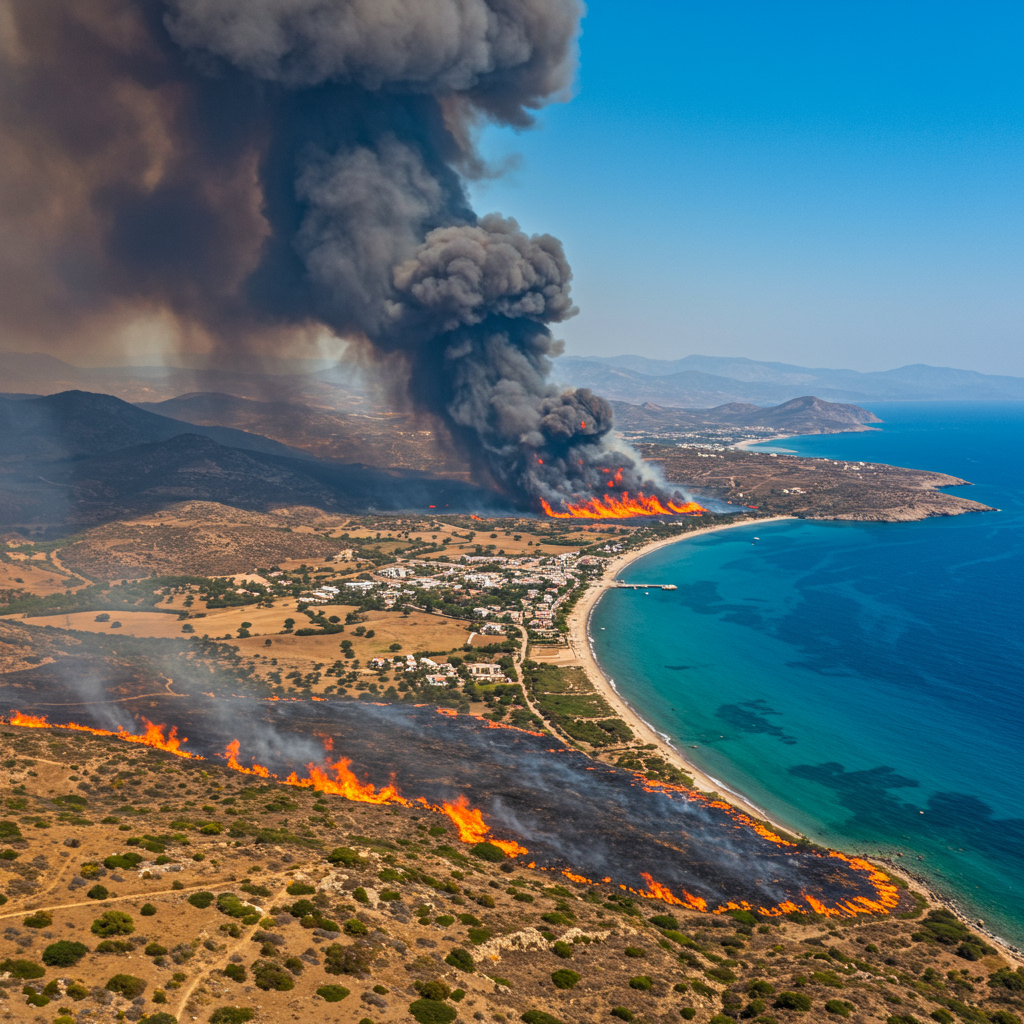Europe is currently facing an unprecedented environmental and humanitarian crisis. A relentless, record-setting heatwave is gripping the continent, pushing temperatures to dangerous extremes. This blistering heat, combined with widespread drought and strong winds, is fueling devastating wildfires across numerous countries. On the large Greek island of crete, emergency services are battling a massive blaze near Ierapetra that has forced thousands of people to evacuate their homes and hotels. The situation on Crete is a stark example of a deadly scenario unfolding across Southern Europe and beyond, impacting nations like Spain, Italy, France, Portugal, Turkey, and Germany. Authorities are overwhelmed, issuing urgent warnings to both residents and tourists as the extreme weather underscores the escalating impacts of climate change.
Crete Ablaze: Mass Evacuations as Fire Tears Through Coastal Areas
A rapidly advancing wildfire triggered significant evacuations on the Greek island of Crete. The conflagration ignited late Tuesday in the rugged mountainous terrain located between the villages of Ferma, Achila, and Agia Fota. Fierce and unpredictable winds quickly fanned the flames, driving the fire relentlessly towards the coast. Homes, businesses, and tourist accommodations near the port city of Ierapetra on the southern edge of the island found themselves directly in the path of the blaze.
Emergency evacuation orders were issued swiftly for three specific locations just outside Ierapetra. The wildfire raged uncontrollably throughout the night. Official reports from fire brigade and civil protection officials confirmed at least 1,500 people were evacuated. Some individuals trapped on beaches were safely rescued by boats and coastguard vessels. However, the president of a local hotelier’s association provided a higher estimate, stating approximately 5,000 people, primarily foreign tourists, were moved from hotels and residences in the affected area.
Evacuated tourists sought refuge in a local basketball arena. Others were relocated to hotels in different parts of the island. Local fishermen and divers also played a crucial role, assisting in the rescue of people who had fled into the sea to escape the intense heat and smoke. The wildfire consumed numerous homes and scorched vast tracts of forested hillsides. Tragically, several individuals required hospital treatment for respiratory problems stemming from smoke inhalation. Civil protection officials described the unfolding situation as “very difficult,” emphasizing that the fire was “very hard to contain” due to the challenging conditions. Firefighters highlighted the immense difficulty posed by the winds, which reached gusts up to nine on the Beaufort scale (around 80 km/h or 50 mph) and constantly shifted direction, making the fire’s behaviour highly erratic.
Approximately 230 firefighters initially confronted the blaze overnight, working tirelessly on the ground. Ten water-dropping aircraft were deployed from first light the following morning, with additional aerial support arriving later from Athens. By Thursday morning, over 150 firefighters remained active on the scene. Aircraft operations were grounded overnight due to the unsafe conditions. Efforts during the night, without aerial support, concentrated on saving homes. Specialized teams worked by hand to dig protective firebreaks on hillsides. Emergency crews strategically positioned water trucks and firefighting equipment along coastal roads in an attempt to halt the fire’s advance.
Continent Under Siege: Deadly Heat and Widespread Blazes Ignite Europe
The wildfire crisis gripping Crete is not an isolated incident but part of a much larger, dangerous pattern. A severe and sweeping European heatwave is impacting vast swathes of the continent. This period of intense heat has tragically been linked to at least eight deaths across various European nations, with reports suggesting figures could be higher. Temperatures have soared well above 40°C in several countries, including Spain, Italy, Greece, France, and Portugal.
Heat and Fire Impacts Across Multiple Nations
Spain is enduring what is being called its hottest summer on record. Some regions have reported temperatures exceeding 42°C. The combination of intense heat and devastating wildfires has led to tragic fatalities. Two farm workers perished in Catalonia after becoming trapped by fast-moving flames. Another wildfire in Lleida province, which burned over 5,500 hectares of primarily agricultural land, resulted in two deaths from smoke inhalation. Barcelona experienced its hottest June in over a century. In a separate tragic incident, a two-year-old child died after being left in a parked car in the sun. Spain’s Ministry of the Interior reported emergency services battling blazes that had consumed more than 6,500 hectares nationally. Spain’s weather agency, Aemet, forecast continued high temperatures, potentially reaching 41°C in cities like Córdoba, with exceptionally warm overnight lows possibly not dropping below 28°C in certain areas.
In Italy, the severe heatwave has resulted in fatalities on the island of Sardinia. Two men, aged 60 and 75, collapsed and died on beaches where temperatures climbed past 40°C. An elderly man in Genoa also died from heart failure shortly after arriving at a hospital, overwhelmed by the heat. Further heat-related deaths were reported for a 47-year-old construction worker near Bologna and a 53-year-old woman in Palermo. Italy issued red alerts, the highest level of heat warning, for 18 cities, indicating a risk to all individuals, not just vulnerable groups. The Civil Protection Agency strongly advised people to avoid prolonged sun exposure and ensure constant hydration. The heatwave also raised concerns about potential temporary power blackouts in Rome due to the strain on the grid from increased air-conditioner usage. Italian authorities have recommended halting outdoor work during the hottest part of the day, although this guidance is not mandatory.
France is similarly experiencing severe heat conditions. While temperatures in the south-east were forecast to reach up to 36°C before some expected easing, a tragic incident occurred involving the death of a 10-year-old American girl who collapsed while visiting the Palace of Versailles. France’s national weather agency, Météo France, issued red alerts for several regions, including Aube, Cher, Loiret, and Yonne, emphasizing the danger to even healthy individuals. The extreme temperatures led to the closure of approximately 2,200 schools nationwide as a precautionary measure. Earlier in the heatwave, a significant fire near Toulouse burned through 400 hectares, reportedly started by a poorly extinguished barbecue, prompting the ecology transition minister to describe the situation as “unprecedented” with a record 84 out of 96 mainland departments on the second-highest ‘orange’ heat alert.
Portugal recorded its highest temperature of the year at 40.5°C. While coastal areas like Lisbon offer some relative relief, interior regions face a critically high risk of wildfires. The National Authority for Civil Protection issued red alerts for rural areas, warning residents and tourists about the significant fire hazards posed by the dry, hot conditions.
Germany is anticipating the heatwave’s shift eastward. Heat warnings have been issued across the country, with forecasts predicting potentially record-breaking highs near 40°C. Such temperatures could lead to disruptions in transportation networks. The country has also reported significant forest fires. Blazes near Gohrischheide, situated on the border between Saxony and Brandenburg, involved nearly 500 firefighters battling flames burning across hundreds of hectares. These fires proved exceptionally difficult to control, partly because they are located on a former military training area containing unexploded ammunition, preventing firefighters from directly accessing and extinguishing outbreaks. Tragically, two emergency workers were severely injured while fighting these fires in Germany.
Turkey is also confronting extensive and deadly wildfires. Two fatalities were reported near Odemis, east of Izmir province. One victim was an elderly, bedridden patient who could not be evacuated from their home. The second was a dedicated forest worker. Wildfires have particularly impacted the western Izmir province. Over 50,000 people were evacuated, primarily from Izmir and Hatay. A significant fire near Cesme, west of Izmir, necessitated further village evacuations and temporarily closed the highway connecting Izmir to Cesme. Izmir governor Suleyman Elban stated that high winds, gusting up to 53mph (85 km/h), were the primary challenge for firefighting efforts. Authorities deployed substantial resources, including nine planes, 22 helicopters, and 1,100 vehicles. The governor indicated initial findings suggested the fires in Izmir were caused by power cables. A meteorologist cited figures estimating that 90% of forest fires are man-made, noting that poorly maintained power cables, particularly since privatization, represent a significant risk factor. Other fires near popular tourist areas like Antalya and Istanbul were quickly contained. Turkey has responded to hundreds of fires since Friday and is grappling with the long-term effects of drought, exacerbated by climate change. According to the European Forest Fire Information System (EFFIS), Turkey recorded 90 wildfires recently, devastating nearly 87,000 acres, a figure that surged dramatically in just days.
Other parts of Greece are also battling separate fire fronts. Reports indicate blazes were burning in the Halkidiki region, requiring 160 firefighters and 49 vehicles. Fires on the islands of Kythira and in Chalkidiki reportedly continue to burn uncontrollably. Authorities warn that the risk of fires remains extremely high not only in Crete but across southern Greece. Greece’s fire service had already tackled dozens of wildfires earlier this year, highlighting the persistent threat.
Understanding the Crisis: Heat, Wind, Drought, and Climate Change Links
Experts consistently link this pattern of extreme weather events to human-induced climate change. The United Nations’ climate agency, the World Meteorological Organization (WMO), explicitly states that extreme temperature shifts occurring globally represent a growing and dangerous threat. They confirm that human activity is unequivocally making episodes of extreme heat both more frequent and more intense. Scientists point to warming sea temperatures in the Mediterranean and surrounding areas as a factor encouraging the formation of a persistent “heat dome” over Europe. This atmospheric phenomenon effectively traps hot air at ground level, preventing it from dissipating.
Europe’s current heatwaves arrived notably earlier than usual this year. Temperatures have surged by as much as 10°C above average in some regions. The past week saw locations in Spain, Portugal, and even the high-altitude Alps record all-time heat records for this specific time of year. Much of eastern and northern Europe is also affected by severe drought conditions. This includes western Turkey, which the European Drought Observatory has classified as experiencing warning-level drought. Serbia and Central Albania have also reported drought impacting agriculture.
The combination of scorching heat, parched ground from drought, and strong, often erratic, winds creates the perfect, highly volatile conditions for wildfires. Strong winds, sometimes reaching gale force as seen in Crete and Turkey, are a major contributing factor once fires ignite. They dramatically increase the speed and distance a fire can spread, hinder control efforts for firefighters, and easily spark entirely new outbreaks far from the main fire front. July is historically the hottest and most challenging month for fire season in the Mediterranean region, often bringing these dangerous strong winds. Beyond fire risk, the heatwave has caused other impacts, including record high Mediterranean sea temperatures (averaging 26.01°C in June), linked to an increase in venomous invasive marine species, and has raised concerns about the “heat island effect” in cities exacerbating risks, along with potential negative impacts on mental health.
Response Efforts, Significant Challenges, and Urgent Safety Warnings
Emergency services across Europe are reportedly stretched thin and sometimes overwhelmed by the scale and intensity of the crisis. This widespread strain has led to the activation of the European Union’s civil protection mechanism. This mechanism facilitates coordinated support to member states facing major emergencies. Countries like Greece, France, and Spain are receiving crucial satellite data from the EU’s Copernicus Emergency Management Service, which helps authorities map and manage fire outbreaks. International cooperation is proving vital in coordinating responses to such large-scale, cross-border crises.
Firefighting efforts face significant and often compounding challenges. Strong winds remain the most prominent obstacle, making fires unpredictable and incredibly difficult to contain, as vividly demonstrated in Crete and Turkey. On Crete specifically, the island’s dry, uneven landscape, marked by deep gullies, further complicates access for ground crews. In Germany, the blazes on a former military area near Gohrischheide present a unique and severe hazard: the presence of unexploded ammunition prevents firefighters from directly attacking outbreaks, requiring indirect strategies and increasing risk for personnel. Power outages and communication network disruptions have also hampered operations in some affected areas, like parts of Crete, making coordination harder during critical overnight periods.
Authorities across all affected nations are issuing urgent warnings and clear safety guidelines for both local populations and tourists. The general advice is consistent:
Stay indoors: Remain inside during the hottest parts of the day, typically from 11 a.m. to 4 p.m.
Stay Hydrated: Drink plenty of water consistently throughout the day.
Dress Appropriately: Wear light-colored, loose-fitting clothing.
Avoid Strenuous Activity: Do not engage in demanding physical exercise outdoors during peak heat hours.
Monitor Local Information: Stay informed by checking local news, weather forecasts, and official advisories from civil protection agencies and authorities.
Be Prepared for Evacuation: If in an area at risk of fire, understand evacuation routes and procedures, and be ready to leave immediately if instructed. Follow all instructions from emergency services promptly.
The UK’s Foreign, Commonwealth, and Development Office (FCDO) has issued travel advisories urging British tourists in affected areas to closely monitor local heat and fire warnings. Residents in high-risk areas of Crete were strongly advised against attempting to return home prematurely. Emergency alerts were successfully sent via mobile phones to warn people in danger zones. The tragic fatalities reported across the continent serve as a stark and sobering reminder of the extreme dangers posed by this crisis. The current emergency in Greece, particularly the scale of the Crete fire, brings back painful memories of the devastating 2018 Mati fire near Athens, which resulted in over 100 deaths. Weather forecasts indicate that the dangerous combination of heat, drought, and wind is likely to persist in the coming days, increasing the risk of further fire outbreaks.
Frequently Asked Questions
What is behind the intense European heatwave and widespread wildfires?
The primary driver is a severe, prolonged heatwave characterized by record-setting high temperatures across Southern Europe, exacerbated by widespread drought conditions. This creates extremely dry vegetation that ignites easily. Strong, erratic winds then significantly spread the flames. Scientists attribute this pattern of increasingly frequent and intense extreme heat events directly to human-induced climate change, noting phenomena like a “heat dome” trapping hot air and warming seas contributing to the conditions.
Which regions in Europe are currently facing the worst impacts?
The crisis is impacting multiple countries. Major wildfires and extreme heat are severely affecting Greece (especially Crete, with other fires in Halkidiki and Kythira), Spain (multiple deadly fires and record heat, notably in Catalonia, Lleida, and cities), Italy (deadly heat and red alerts in numerous cities like Sardinia, Genoa, Palermo), France (severe heat alerts, school closures, previous fires), Portugal (high temperatures, rural fire risk), Turkey (extensive fires, mass evacuations in Izmir, Hatay, Cesme), and Germany (eastward heat shift, forest fires with unique challenges).
What critical safety steps should tourists and residents take in affected European regions?
Authorities are urging everyone in affected areas to prioritize safety by taking specific precautions. This includes staying indoors during the peak heat hours (typically 11 a.m. to 4 p.m.), ensuring adequate hydration by drinking plenty of water, wearing light and loose clothing, and avoiding strenuous outdoor physical activity. It is also crucial to continuously monitor local news and official warnings from civil protection agencies and be prepared to follow evacuation orders immediately if in an area at risk of wildfires. Tourists should also check travel advisories from their home country.
Conclusion
The current wildfires tearing across Crete and multiple other nations underscore the severe and immediate threats posed by the combination of a dangerous heatwave, widespread drought, and strong winds across Europe. This crisis is a stark illustration of the escalating reality of extreme weather events. Emergency services and international partners are working tirelessly to manage the fires and protect lives through mass evacuations, though challenges posed by the conditions are immense. The human cost is tragically evident in the reported fatalities across the continent. Experts consistently link the increasing frequency and intensity of such events to human-driven climate change, highlighting the critical need for long-term global action alongside immediate response. For those in or traveling to affected regions, remaining vigilant and strictly following local advisories and safety guidelines is absolutely essential during this challenging period.



